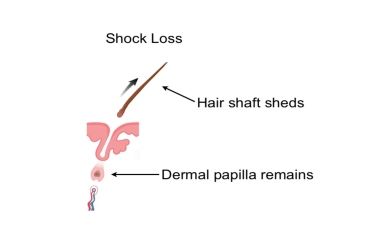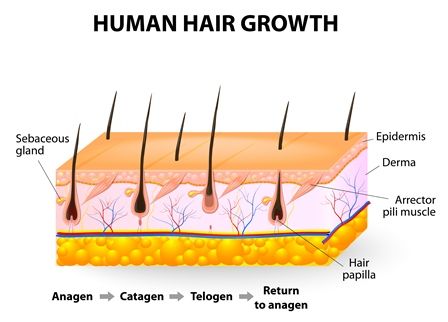Shedding after a Hair Transplant
Hair shedding is considered a normal function of the body, as it is quite common to shed anywhere between 50-100 hairs a day. It is, however, important to clearly distinguish between normal shedding and the post-operative shedding of transplanted hair grafts.
Shedding of Normal, Non-Transplanted Hair
Hair goes through a cycle of growth and shedding made up of the anagen, catagen and telogen stages. This cycle, unlike the hair growth cycles of other mammals, is completely random, and a varying number of hairs can be in any one of these phases at any given time.
The anagen phase is otherwise known as the active phase of hair, and lasts for about 2-6 years. During this phase, hair grows about 1cm every 28 days. The catagen phase is referred to as the “transitional phase”, and lasts for 2-3 weeks. At any given time, about 3% of all hairs are in this phase. The telogen phase, otherwise known as the “resting” phase, is where most shedding occurs. About 6-8% of all hairs can be in the telogen phase, and can last for about 100 days. During this time, as much as 50-100 hairs are shed.
Post-Operative Shedding of Transplanted Hair Grafts and Existing Hair
Patients often report continued hair shedding after undergoing a hair transplant procedure. It is important to note that hair shedding after a hair transplant is a normal occurrence and is the body’s way of responding to the trauma it received during the hair transplant procedure

Shock loss caused by trauma of a hair transplant, causing native hairs to temporarily shed. While the hair is shed due to trauma, the dermal papilla remains so hair does grow back.
A hair transplant procedure is the movement and individual placement of genetically resistant hairs from the donor area (located at the back of the head) to the areas where the scalp is losing hair. Tiny openings are created—otherwise referred to as “stab incisions”—wherein the individual grafts are placed. Regardless of whether FUT or FUE is performed, the procedure can be quite traumatic on the scalp and the surrounding hairs, and as a result, the hair grafts and the existing hairs can temporarily shed. This occurrence is called “effluvium”, and is sometimes referred to as “shock loss”
Shedding of hair grafts after a hair transplant can be noticed anywhere between 1-5 weeks after the hair transplant procedure. Patients are often alarmed by the continued loss of hair, however, a few months after the procedure; they can be assured that new hairs will eventually grow back again. Keep in mind that “shock loss” is a normal part of the hair restoration process and is not indicative of any permanent damage on the hair – though it is unavoidable, it is also temporary. New hairs will take time to mature and will grow at different rates.
Interestingly, the more severe one’s hair loss and hair miniaturization is, the more likely that person will experience increased hair shedding after a hair transplant.
Keep in mind that “shock loss” is a normal part of the hair restoration process and is not indicative of any permanent damage on the hair – though it is unavoidable, it is also temporary. New hairs will take time to mature and will grow at different rates.
How to Reduce Hair Shedding after a Hair Transplant
Though hair shedding or shock loss is unavoidable, there are a few things you can consider in order to minimize the amount of hairs lost after a hair transplant.
1. Medication
Minoxidil (sold under the brand names Rogaine® and Regaine®) increases hair growth and darkens fine hairs—yielding results within about 4-6 months. Rogaine, in particular, has been known to be more effective on people younger than 30 years old and who have only been experiencing hair loss for less than 5 years. While the body normally tolerates Rogaine well, side effects have been reported and may include eye irritation, itching, redness and/or irritation of the area, and unwanted hair growth in other parts of the body.
Finasteride (sold under the brand name Propecia®) works by binding to the enzyme 5-Alpha Reductase responsible for helping produce DHT in the body. It does not completely stop DHT production, but rather, suppresses it well enough to interrupt the development of male pattern hair loss and hair miniaturization in men. When used regularly, results may be seen in as early as 3 months. Some men may experience decreased libido when taking the drug. Some men may also experience erectile dysfunction and a decrease in the amount of semen released during sex. Finasteride does not work on all men, and hair thinning and hair loss are not based on DHT alone as they can continue when on the medication.
Dr. Amiya Prasad’s Hair Regeneration Treatment is also an effective way to minimize postoperative shedding. The Hair Regeneration Treatment is made up of an extracellular matrix designed for wound healing and platelet-rich plasma, which is taken from the patient’s own blood. The mixture is then injected into areas of the scalp where hair loss is evident. There is a 99% treatment success rate in cases of male pattern and female pattern hair loss. The wound healing properties of the Hair Regeneration Treatment also improves the survival rate of hair grafts.
2. Timing and Size of Hair Transplant
Many patients choose to have a hair transplant at the onset of hair loss or when they have significant miniaturization. When patients take this kind of approach, their hair often ends up looking thinner than it did before the procedure was performed because the progression of the hair shedding was not taken into account.
Another approach would be to wait until a later date after the hair loss has been stabilized with a procedure like Hair Regeneration. It is also essential for the surgeon to carefully determine a suitable number of grafts required for the desired area of coverage and the estimated number of hair grafts available in the donor area.
3. Camouflaging Products
Patients may opt for cosmetic camouflaging products which can disguise the physical evidence of hair shedding and hair thinning. These products cover up balding areas by adding volume and lift to the base of the hair shafts, incorporating hair building fibers for fuller coverage and thickness, and employing topical shading to disguise bare spots on the scalp.
http://www.ncbi.nlm.nih.gov/pmc/articles/PMC2684510/

